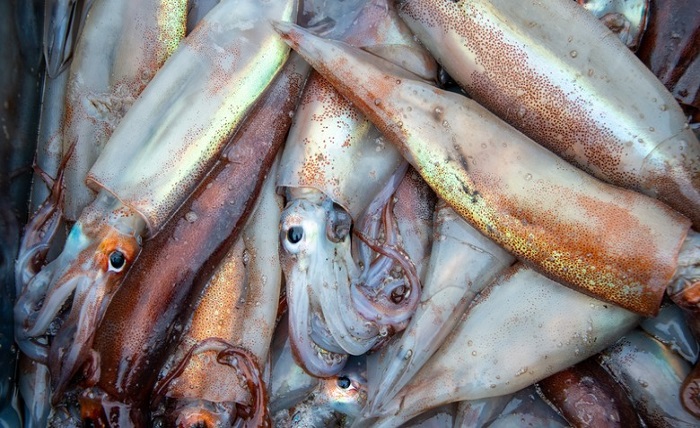The Deeply Fascinating Squid: Secrets of the Ocean’s Ink-Slinging Master

A creature of fascinating paradoxes, the squid, rises from the mysterious depths of the ocean. For millennia, the sleek, torpedo-shaped bodies, captivating eyes, and ability to vanish into a cloud of ink have all contributed to the fascination of squids in human imagination. However, there is a world much more amazing than sushi platters and Hollywood portrayals—one in which sharp intellect, dexterity, and vivid variety are valued above all else.
Unveiling the Squid’s Anatomy:
Though superficially resembling fish, squids belong to the mollusc family, sharing closer kinship with snails and octopuses. Their soft, elongated bodies lack the bony skeleton of their finned counterparts, instead supported by a slender internal “pen” made of chitin. Eight muscular arms, adorned with rows of suction cups, provide a powerful grip, while two longer tentacles unfurl with lightning speed to snatch unsuspecting prey. Their large, complex eyes boast incredible vision, capable of detecting both light and polarization, giving them a nuanced view of their underwater world.
Jet Propulsion: Masters of Maneuvering:
Forget fins! Squids propel themselves through the water via a sophisticated form of jet propulsion. By rhythmically contracting their mantle cavity and forcefully expelling water through a siphon, they create a powerful thrust, allowing them to dart, hover, and even zip backwards with breathtaking agility. This innate talent makes them skilled escape artists, leaving predators trailing in a bewildered ink cloud.
A Palette of Ink: Defense and Deception:
The squid’s most iconic defense mechanism is, of course, their ink sac. This pressurized pouch holds a concentrated concoction of melanin and other chemicals, which, when released, creates a dense black cloud in the water. This not only disorients predators but also provides cover for the squid to make a swift getaway. Some species even customize their ink with bioluminescent compounds, creating a dazzling light show to further confuse pursuers.
Hunting Prowess: From Stealthy Ambush to Active Pursuit:
The squid’s diet is as diverse as their habitats. Smaller varieties feast on plankton and krill, while larger species like the Humboldt squid become formidable predators, hunting fish, shrimp, and even other squids. Their flexible arms and razor-sharp beaks make them efficient hunters, employing tactics like stealthy ambushes or lightning-fast chases to secure their meals.
The Symphony of Senses: A World Beyond Sight:
While vision plays a pivotal role in their lives, squids possess a symphony of other senses to navigate their watery world. Sensitive smell receptors detect chemical trails of prey and predators, while taste buds on their arms discern flavors. Tactile hairs scattered across their body provide constant feedback on water currents and potential dangers. This multi-sensory perception paints a complex picture of their surroundings, allowing them to thrive in a dynamic underwater environment.
Social Squid Squads? Unraveling the Mysteries of Intelligence:
Long considered solitary creatures, recent research suggests a surprising side to squid behavior: social intelligence. Certain species, like the Humboldt squid, have been observed hunting cooperatively, coordinating attacks and sharing information about prey location. Studies also indicate complex problem-solving abilities and impressive memory retention, challenging our understanding of cephalopod cognition.
A Keystone Species: Balancing the Ocean’s Scales:
Squid play a crucial role in the delicate balance of the marine ecosystem. As voracious predators, they keep populations of smaller fish in check, while their own bodies serve as vital food sources for larger marine animals, including dolphins, whales, and sharks. This intricate web of predator-prey relationships ensures the health and stability of the entire ocean food chain.
From Delicacy to Disaster: The Human Impact on Squid:
Squid are a culinary delicacy in many cultures, featuring prominently in dishes across the globe. However, their popularity has come at a cost. Overfishing threatens some populations, while pollution and habitat degradation further impact their well-being. Understanding the delicate balance of the ocean and implementing sustainable fishing practices are crucial to ensuring the future of these remarkable creatures.
Conclusion:
From their jet-propelled acrobatics to their ink-fueled escapes, squids embody the mesmerizing diversity and wonder of the ocean depths. These intelligent, adaptable creatures play a vital role in the marine ecosystem, reminding us of the interconnectedness of our planet. As we delve deeper into their world, we not only gain a newfound appreciation for their unique adaptations but also a powerful call to action: to protect and preserve the delicate balance of life in our oceans.



